
A willy warmer (or cock sock) is a novelty garment designed to fit over the penis. [1]

A willy warmer (or cock sock) is a novelty garment designed to fit over the penis. [1]
According to the Croatian knitter Radmila Kus, knitted protector (nakurnjak [2] [3] ) was traditionally worn by Croatian men, particularly in the Mrkopalj mountain region, as a guard against frostbite. [4] Such garments were also worn in Norway, where they were called forhyse, vænakot, or suspensorium. [5] Several examples are preserved in the Norwegian Museum of Cultural History. [5] Sometimes in Norway they would be made from squirrel fur with the fur side inside, to be worn under leather trousers in the winter. [6] [7] On the Faroe Islands such garments are called kallvøttur (man mitten) or purrivøttur (testicles mitten). [7] There was a tradition in Norway and Denmark, particularly on the Faroe Islands, where a girl would present her boyfriend with a forhyse to see how seriously he took their relationship. If the gift was rejected, this was seen as evidence that he was not yet ready for marriage. [6]
Since the 20th century, willy warmers are usually made as novelties and joke gifts rather than to serve a functional purpose. [8] In 1939, while filming Gone with the Wind , Clark Gable received a present of a hand-knitted genitalia warmer from Carole Lombard. [9] In the 1950s, Joan Crawford knitted a "cock sock" as a parting present for Porfirio Rubirosa. [10]
Dawn Steel, while working as a merchandiser for Penthouse in the early 1970s, found hand-knitted "cock socks" in Frankfurt, and subsequently secured the rights to market "extra large" red, blue and white versions through the magazine. [11] [12] [13] By the early 1980s, the seaside resort Blackpool had willy warmers displayed alongside other merchandise in gift shops just outside the Pleasure Beach, where they were seen as reflecting the limit of sexually suggestive material which was considered permissible to display publicly. [14] It was claimed in 1991 that King Charles III, received a green knitted warmer one Christmas, which was stored with other unusual gifts in the cellar at Highgrove House. [1]
In male nude photography, as published in magazines such as Playgirl , cock socks have become a humorous substitute for the fig leaf, deliberately focusing attention upon the area concealed. [15] In 1990–91, during the Gulf War, the British tabloid newspaper The Sun printed a pattern for a willy warmer, which it encouraged female readers to knit and send to soldiers in the Gulf. [16] Early 21st century willy warmers are often made to represent religious or political themes, or in the form of animals. [17] For example, in 2004 Ann Summers offered a horse's head design with a neighing speaker. [8] British reality TV star Bobby-Cole Norris has repeatedly made headlines for his choice of willy warmers as swimwear, including both a simple pouch [18] and an anatomically correct variety. [19]
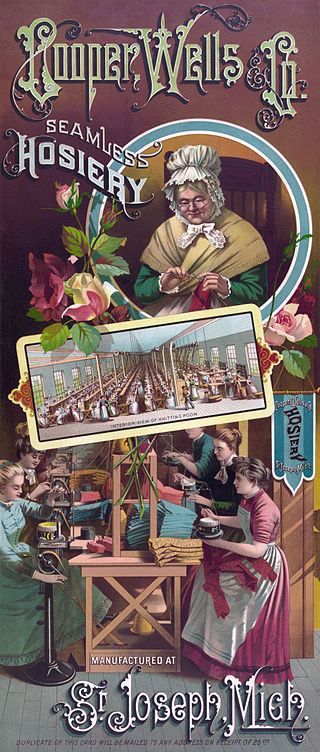
Hosiery, also referred to as legwear, describes garments worn directly on the feet and legs. The term originated as the collective term for products of which a maker or seller is termed a hosier; and those products are also known generically as hose. The term is also used for all types of knitted fabric, and its thickness and weight is defined by denier or opacity. Lower denier measurements of 5 to 15 describe a hose which may be sheer in appearance, whereas styles of 40 and above are dense, with little to no light able to come through on 100 denier items.

A codpiece is a triangular piece that attached to the front of men's hose, covering the fly. It may be held in place by ties or buttons. It was an important fashion item of European clothing during the 15th–16th centuries, in the 16th century becoming a firm upwards-pointing projection based on a stiff material such as boiled leather, or in plate armour, steel.

Stockings are close-fitting, variously elastic garments covering the leg from the foot up to the knee or possibly part or all of the thigh. Stockings vary in color, design, and transparency. Today, stockings are primarily worn for fashion and aesthetics, usually in association with mid-length or short skirts.
A knit cap is a piece of knitted headwear designed to provide warmth in cold weather. It usually has a simple tapered shape, although more elaborate variants exist. Historically made of wool, it is now often made of synthetic fibers.

Extreme cold weather clothing is clothing for arctic or mountainous areas. Its primary function is to trap air as an insulator to prevent heat loss from the wearer's body. Secondary and necessary is to conduct water vapor away from the body to keep the insulating layers dry. A shell keeps the wind from disturbing the still air in the insulating layers. In warmer conditions, the shell protects from water intrusion.

A scarf is a long piece of fabric that is worn on or around the neck, shoulders, or head. A scarf is used for warmth, sun protection, cleanliness, fashion, religious reasons, or to show support for a sports club or team. Scarves can be made from materials including wool, linen, silk, and cotton. It is a common type of neckwear and a perennial accessory.
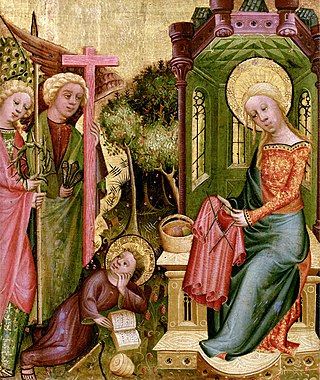
Knitting is the process of using two or more needles to pull and loop yarn into a series of interconnected loops in order to create a finished garment or some other type of fabric. The word is derived from knot, thought to originate from the Dutch verb knutten, which is similar to the Old English cnyttan, "to knot". Its origins lie in the basic human need for clothing for protection against the elements. More recently, hand knitting has become less a necessary skill and more of a hobby.

A mitten is a type of glove that covers the hand but does not have separate finger openings or sheaths. Generally, mittens still separate the thumb from the other four fingers. They have different colours and designs. Mittens provide greater thermal insulation than gloves as they have a smaller surface area exposed to the cold, but have a trade-off in dexterity.

Nålebinding is a fabric creation technique predating both knitting and crochet. Also known in English as "knotless netting", "knotless knitting", or "single-needle knitting", the technique is distinct from crochet in that it involves passing the full length of the working thread through each loop, unlike crochet where the work is formed only of loops, never involving the free end. It also differs from knitting in that lengths must be pieced together during the process of nålebinding, rather than a continuous strand of yarn that can easily be pulled out. Archaeological specimens of fabric made by nålebinding can be difficult to distinguish from knitted fabric.
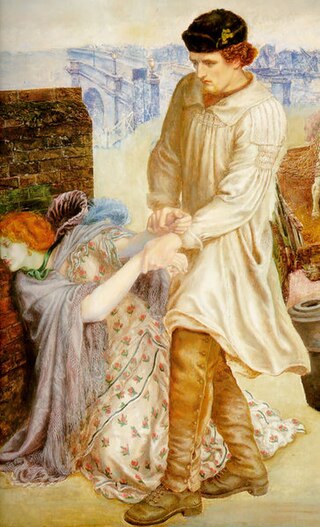
A smock-frock or smock is an outer garment traditionally worn by rural workers, especially shepherds and waggoners. Today, the word smock refers to a loose overgarment worn to protect one's clothing, for instance by a painter.
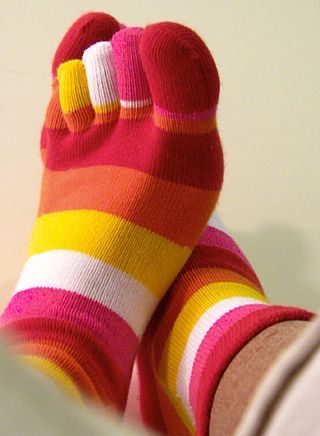
Toe socks are socks that have been knitted so that each toe is individually encased the same way as fingers within a glove.

Clothing fetishism or garment fetishism is a sexual fetish that revolves around a fixation upon a particular article or type of clothing, a particular fashion or uniform, or a person dressed in such a style.

A sweater vest is an item of knitwear that is similar to a sweater, but without sleeves, usually with a low-cut neckline. They were popular in the 20th century, particularly in the 1970s in the UK, and are again growing in popularity in the 21st century.
Hand knitting is a form of knitting, in which the knitted fabric is produced by hand using needles.
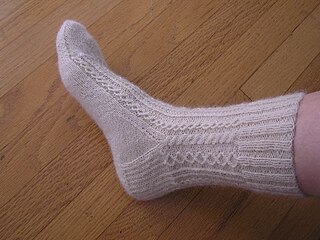
A sock is a piece of clothing worn on the feet and often covering the ankle or some part of the calf. Some types of shoes or boots are typically worn over socks. In ancient times, socks were made from leather or matted animal hair. In the late 16th century, machine-knit socks were first produced. Until the 1800s, both hand-made and machine-knit socks were manufactured, with the latter technique becoming more common in the 19th century, and continuing until the modern day.

The Faroese sheep is a breed of sheep native to the Faroe Islands.

Norwegian knitting (strikking) has a history dating from the 16th century.

Selbuvott is a knitted woolen mitten, based on a pattern from Selbu in Norway. Like all mittens, the purpose of selbuvott is to keep hands warm during winter, with one large space for fingers and a separate smaller section for the thumb. The pattern is a Selburose, which is a traditional rose from the Selbu area, shaped like an octagram. Marit Guldsetbrua Emstad first knitted the pattern into a pair of mittens in 1857, and sold it through Husfliden in Trondheim in 1897. Selbuvott is possibly the most-worn knitted pattern in Norway.
Thrumming is a technique in which small pieces of wool or yarn (thrums) are pulled through fabric to create a wooly layer. The term thrum originally referred specifically to worthless pieces of warp thread which remained after weaving a piece of fabric using a loom, though its meaning has since broadened to include any small pieces of wool or thread which are used in a similar way.

Twined knitting is a traditional Scandinavian knitting technique. It refers to knitting where two strands of yarn are knitted into the fabric alternatively and twisted once and always in the same direction before every stitch. The technique is called tvåändsstickning in Swedish, tvebandsstrikking in Norwegian, and tvebinding in Danish. Their literal meaning is "two-end knitting", referring to the traditional way of knitting with both yarn ends from one ball of yarn.